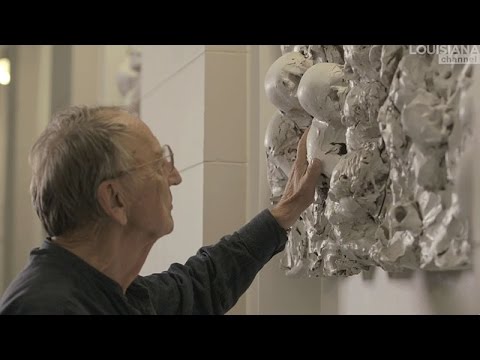
”Sometimes I wonder if mankind is the happiest when it kills. Whether we are some sort of castrated mankind that has learned to tame itself in order to be able to live together.” Meet Danish sculptor Jørgen Haugen Sørensen for a conversation about art, society and the beast within us.
Just before his 80th birthday, Jørgen Haugen Sørensen (b. 1934) finished an artwork that already now is regarded as a modern classic. For the Copenhagen courthouse Sørensen shaped a series of reliefs that confront society with it’s dark sides. ”We’re up against chaos. We’re up against violence. Theft. Stupidity. Dog fights. And we’re up against ourselves and up against our own system.”
For about 200 years the walls in room 60 of the Copenhagen courthouse had been empty. Originally, it was Denmark’s great classical sculptor Bertel Thorvaldsen who was asked to decorate the room, but this project was never realised. So when Jørgen Haugen Sørensen was asked to take on the job, it was with great interest for the fades and stories taking place in the courtroom every day – people confronted by the law which they themselves have broken: ”What creates a society? Obviously, laws determine how a society should look. And it varies from country to country, how we are raised and what laws there are to keep us in line. And a society that we can live in must be formed.”
Consequently, Sørensen chose to confront the people in the courtroom with the dark side of society – motives of violence, murder, the mob. Besides that he formed to sculptures of persons central in every trial – the witnesses and the judge, symbolized through a thoughtful man called Justitio burdened by the responsibility of his task. ”He determines the outcome. And justice is relative too. In actuality, our entire system is built on specific ideas that can be moved, pushed and twisted, depending on the politics of a country. Justitio is dependent on the politics. He’s directed by it. We have a constitution, but they can change that, too. It depends on who’s in power.”
Sørensen then goes on reflecting about the overall relation between society and art. ”Art is important. It’s through art that society breathes. Poetry is what keeps our language alive. It’s not the commercials. They just make us dumber. Artists open up possibilities for a society – that would otherwise fossilize. We let in as much chaos as we can. As much chaos as we are allowed and which isn’t violent. That’s what we do.”
”Art sees through a society. And when someone assumes ultimate power – they’ll try to get rid of as much art as possible. They burn books. Because art is significant even when it’s not consciously noticed. We – the artists – are on the outside looking in at society. Because we participate and yet we don’t. That’s art’s greatest strength. That you have people on the outside looking in.”
On october 3th, 2014, Sørensen celebrated his 80th. birthday. The interview thus ends with some reflection upon age and having lived the greater part of one’s life. ”Is it nostalgic to turn 80? That’s hard to answer. It’s like asking someone what it’s like to be hunchbacked or black. I just am. You slowly become elderly. Age comes, but suddenly you’re old. You don’t think about it, because you can be young at 75 or 78, but suddenly you’re old. You feel it. But in my head I’m still the little jerk I was when I was a boy.”
Jørgen Haugen Sørensen was born in Copenhagen in 1934. He is a self-educated sculptor who today is regarded as one of the most renowned artists in Denmark. Sørensen has been awarded with two of the most presticious prizes in his country – the Eckersberg Medal in 1969 and the Thorvaldens Medal in 1979.
Jørgen Haugen Sørensen was interviewed by Marc-Christoph Wagner.
Camera: Jakob Solbakken
Edited by: Kamilla Bruus
Produced by: Marc-Christoph Wagner
Copyright: Louisiana Channel, Louisiana Museum of Modern Art, 2014
Supported by Nordea-fonden
source